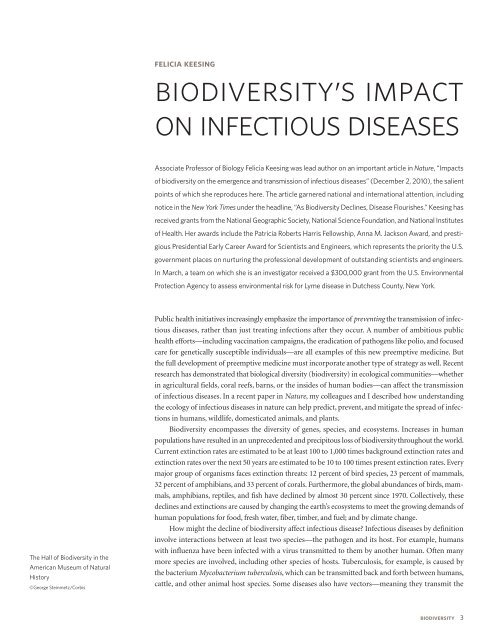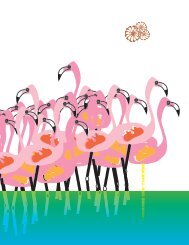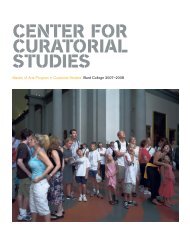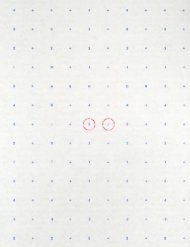Bardian SPRING 2011
Create successful ePaper yourself
Turn your PDF publications into a flip-book with our unique Google optimized e-Paper software.
felicia keesing<br />
biodiversity’s impact<br />
on infectious diseases<br />
Associate Professor of Biology Felicia Keesing was lead author on an important article in Nature, “Impacts<br />
of biodiversity on the emergence and transmission of infectious diseases” (December 2, 2010), the salient<br />
points of which she reproduces here. The article garnered national and international attention, including<br />
notice in the New York Times under the headline, “As Biodiversity Declines, Disease Flourishes.” Keesing has<br />
received grants from the National Geographic Society, National Science Foundation, and National Institutes<br />
of Health. Her awards include the Patricia Roberts Harris Fellowship, Anna M. Jackson Award, and prestigious<br />
Presidential Early Career Award for Scientists and Engineers, which represents the priority the U.S.<br />
government places on nurturing the professional development of outstanding scientists and engineers.<br />
In March, a team on which she is an investigator received a $300,000 grant from the U.S. Environmental<br />
Protection Agency to assess environmental risk for Lyme disease in Dutchess County, New York.<br />
The Hall of Biodiversity in the<br />
American Museum of Natural<br />
History<br />
©George Steinmetz/Corbis<br />
Public health initiatives increasingly emphasize the importance of preventing the transmission of infectious<br />
diseases, rather than just treating infections after they occur. A number of ambitious public<br />
health efforts—including vaccination campaigns, the eradication of pathogens like polio, and focused<br />
care for genetically susceptible individuals—are all examples of this new preemptive medicine. But<br />
the full development of preemptive medicine must incorporate another type of strategy as well. Recent<br />
research has demonstrated that biological diversity (biodiversity) in ecological communities—whether<br />
in agricultural fields, coral reefs, barns, or the insides of human bodies—can affect the transmission<br />
of infectious diseases. In a recent paper in Nature, my colleagues and I described how understanding<br />
the ecology of infectious diseases in nature can help predict, prevent, and mitigate the spread of infections<br />
in humans, wildlife, domesticated animals, and plants.<br />
Biodiversity encompasses the diversity of genes, species, and ecosystems. Increases in human<br />
populations have resulted in an unprecedented and precipitous loss of biodiversitythroughout the world.<br />
Current extinction rates are estimated to be at least 100 to 1,000 times background extinction rates and<br />
extinction rates over the next 50 years are estimated to be 10 to 100 times present extinction rates. Every<br />
major group of organisms faces extinction threats: 12 percent of bird species, 23 percent of mammals,<br />
32 percent of amphibians, and 33 percent of corals. Furthermore, the global abundances of birds, mammals,<br />
amphibians, reptiles, and fish have declined by almost 30 percent since 1970. Collectively, these<br />
declines and extinctions are caused by changing the earth’s ecosystems to meet the growing demands of<br />
human populations for food, fresh water, fiber, timber, and fuel; and by climate change.<br />
How might the decline of biodiversity affect infectious disease? Infectious diseases by definition<br />
involve interactions between at least two species—the pathogen and its host. For example, humans<br />
with influenza have been infected with a virus transmitted to them by another human. Often many<br />
more species are involved, including other species of hosts. Tuberculosis, for example, is caused by<br />
the bacterium Mycobacterium tuberculosis, which can be transmitted back and forth between humans,<br />
cattle, and other animal host species. Some diseases also have vectors—meaning they transmit the<br />
biodiversity 3
















